Chapter 3 Bibliometric Analysis
# install bibliometrix and load data
#install.packages("devtools")
#devtools::install_github("massimoaria/bibliometrix")
library(bibliometrix)## To cite bibliometrix in publications, please use:
##
## Aria, M. & Cuccurullo, C. (2017) bibliometrix: An R-tool for comprehensive science mapping analysis, Journal of Informetrics, 11(4), pp 959-975, Elsevier.
##
##
## http:\\www.bibliometrix.org
##
##
## To start with the shiny web-interface, please digit:
## biblioshiny()library(reshape2)
library(ggplot2)
df <- convert2df(file = "scopus.bib", dbsource = "scopus", format = "bibtex")##
## Converting your scopus collection into a bibliographic dataframe
##
## Articles extracted 97
## Done!
##
##
## Generating affiliation field tag AU_UN from C1: Done!3.1 Descriptive analysis
3.1.1 Attributes of the collection
results <- biblioAnalysis(df, sep = ";")
options(width = 100)
s <- summary(object = results, k = 10, pause = FALSE)##
##
## MAIN INFORMATION ABOUT DATA
##
## Timespan 2002 : 2020
## Sources (Journals, Books, etc) 36
## Documents 97
## Average years from publication 4.62
## Average citations per documents 18.13
## Average citations per year per doc 2.55
## References 7707
##
## DOCUMENT TYPES
## article 92
## book chapter 1
## editorial 1
## review 3
##
## DOCUMENT CONTENTS
## Keywords Plus (ID) 673
## Author's Keywords (DE) 340
##
## AUTHORS
## Authors 401
## Author Appearances 528
## Authors of single-authored documents 11
## Authors of multi-authored documents 390
##
## AUTHORS COLLABORATION
## Single-authored documents 12
## Documents per Author 0.242
## Authors per Document 4.13
## Co-Authors per Documents 5.44
## Collaboration Index 4.59
##
##
## Annual Scientific Production
##
## Year Articles
## 2002 1
## 2006 1
## 2007 3
## 2008 1
## 2010 4
## 2011 7
## 2012 3
## 2013 5
## 2014 9
## 2015 7
## 2016 7
## 2017 12
## 2018 14
## 2019 22
## 2020 1
##
## Annual Percentage Growth Rate 0
##
##
## Most Productive Authors
##
## Authors Articles Authors Articles Fractionalized
## 1 CUCCHI T 9 CUCCHI T 2.32
## 2 GONZLEZ-AGUILERA D 8 THULMAN DK 2.00
## 3 YRAVEDRA J 8 BUCHANAN B 1.67
## 4 ARAMENDI J 7 CARDILLO M 1.58
## 5 COURTENAY LA 7 GUNZ P 1.48
## 6 EVIN A 6 COURTENAY LA 1.24
## 7 MAT-GONZLEZ M 6 O'BRIEN MJ 1.17
## 8 BUCHANAN B 5 GONZLEZ-AGUILERA D 1.12
## 9 CORNETTE R 5 YRAVEDRA J 1.12
## 10 DOBNEY K 5 COLLARD M 1.08
##
##
## Top manuscripts per citations
##
## Paper TC TCperYear
## 1 VIOARSDTTIR US, 2002, J ANAT 146 7.68
## 2 KOVAROVIC K, 2011, J ARCHAEOL SCI 101 10.10
## 3 LYCETT SJ, 2006, J ARCHAEOL SCI 78 5.20
## 4 ARCHER W, 2010, J ARCHAEOL SCI 74 6.73
## 5 BUCHANAN B, 2010, J ARCHAEOL SCI 71 6.45
## 6 THULMAN DK, 2012, J ARCHAEOL SCI 68 7.56
## 7 BERMDEZ DE CASTRO JM, 2011, J HUM EVOL 56 5.60
## 8 KRAUSE-KYORA B, 2013, NAT COMMUN 55 6.88
## 9 HARVATI K, 2010, J HUM EVOL 54 4.91
## 10 OKUMURA M, 2014, J ARCHAEOL SCI 50 7.14
##
##
## Corresponding Author's Countries
##
## Country Articles Freq SCP MCP MCP_Ratio
## 1 UNITED KINGDOM 15 0.2239 5 10 0.667
## 2 FRANCE 14 0.2090 4 10 0.714
## 3 GERMANY 8 0.1194 3 5 0.625
## 4 SPAIN 8 0.1194 4 4 0.500
## 5 ARGENTINA 7 0.1045 4 3 0.429
## 6 USA 5 0.0746 4 1 0.200
## 7 AUSTRIA 2 0.0299 1 1 0.500
## 8 CANADA 2 0.0299 1 1 0.500
## 9 CHILE 2 0.0299 0 2 1.000
## 10 BRAZIL 1 0.0149 1 0 0.000
##
##
## SCP: Single Country Publications
##
## MCP: Multiple Country Publications
##
##
## Total Citations per Country
##
## Country Total Citations Average Article Citations
## 1 UNITED KINGDOM 484 32.3
## 2 GERMANY 216 27.0
## 3 FRANCE 198 14.1
## 4 SPAIN 146 18.2
## 5 ARGENTINA 132 18.9
## 6 CANADA 118 59.0
## 7 USA 87 17.4
## 8 SOUTH AFRICA 74 74.0
## 9 BRAZIL 50 50.0
## 10 AUSTRIA 45 22.5
##
##
## Most Relevant Sources
##
## Sources Articles
## 1 JOURNAL OF ARCHAEOLOGICAL SCIENCE 27
## 2 JOURNAL OF HUMAN EVOLUTION 10
## 3 AMERICAN JOURNAL OF PHYSICAL ANTHROPOLOGY 5
## 4 QUATERNARY INTERNATIONAL 5
## 5 PLOS ONE 4
## 6 QUATERNARY SCIENCE REVIEWS 4
## 7 ARCHAEOLOGICAL AND ANTHROPOLOGICAL SCIENCES 3
## 8 JOURNAL OF ARCHAEOLOGICAL SCIENCE: REPORTS 3
## 9 AMERICAN ANTIQUITY 2
## 10 AMERICAN JOURNAL OF HUMAN BIOLOGY 2
##
##
## Most Relevant Keywords
##
## Author Keywords (DE) Articles Keywords-Plus (ID) Articles
## 1 GEOMETRIC MORPHOMETRICS 43 ARCHAEOLOGY 67
## 2 TAPHONOMY 7 MORPHOMETRY 52
## 3 ZOOARCHAEOLOGY 7 GEOMETRY 24
## 4 ARCHAEOLOGY 6 MALE 24
## 5 EXPERIMENTAL ARCHAEOLOGY 6 ARCHEOLOGY 23
## 6 3D GEOMETRIC MORPHOMETRICS 5 FEMALE 22
## 7 ARCHAEOBOTANY 4 HUMANS 22
## 8 CUT MARKS 4 HUMAN 21
## 9 PALEOINDIAN 4 SKULL 19
## 10 PROJECTILE POINTS 4 HISTORY 18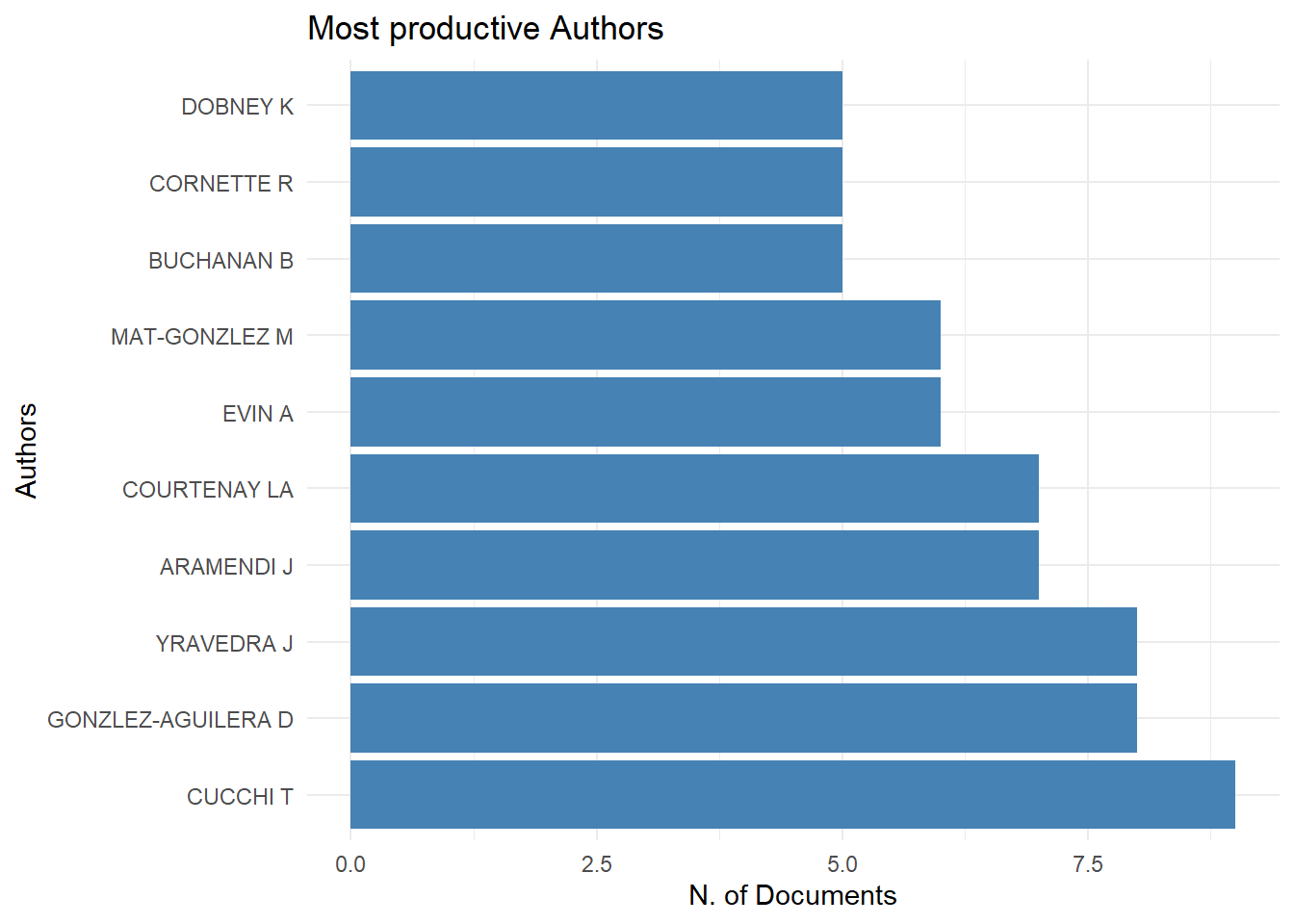
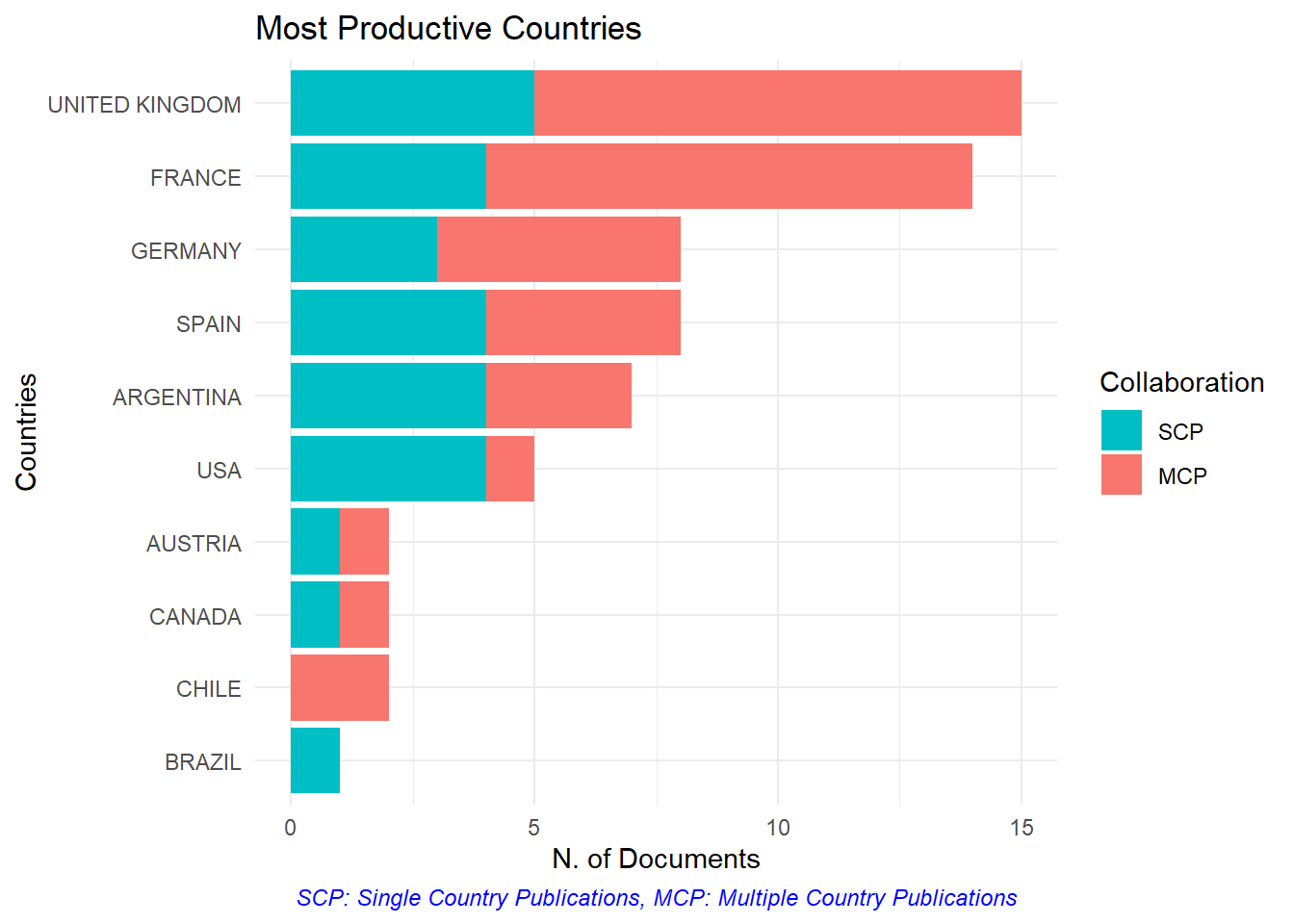

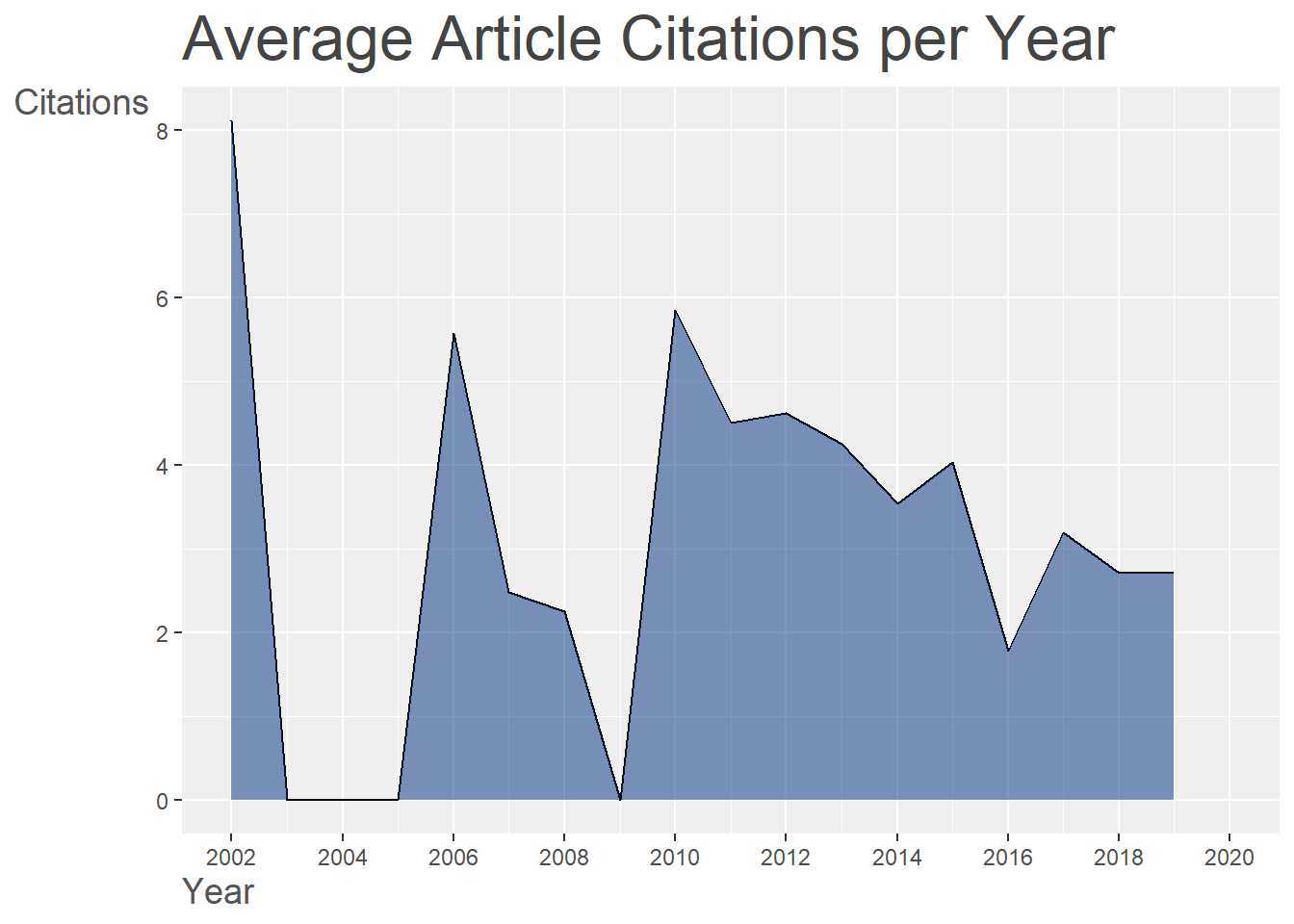
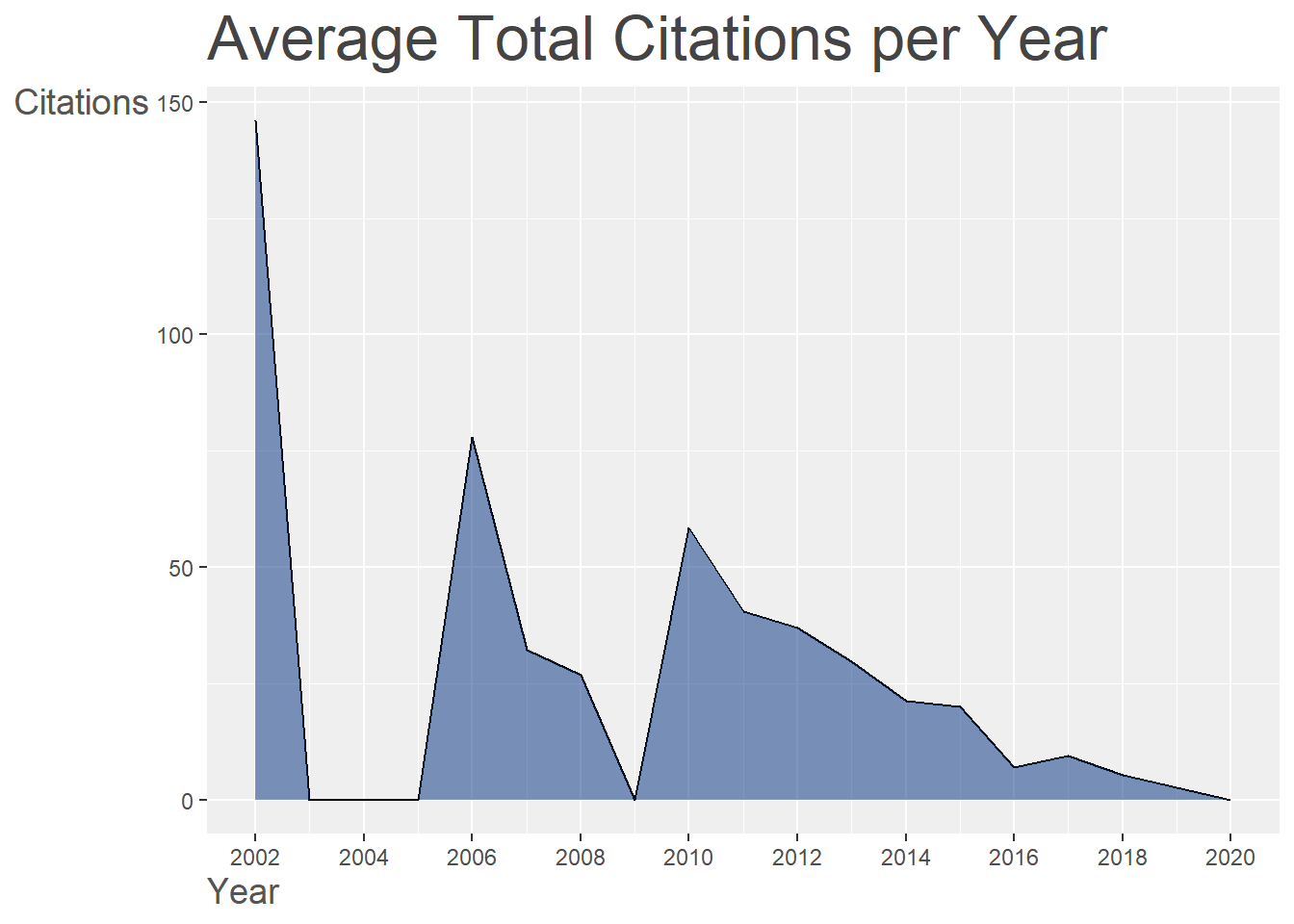
3.1.2 Attributes of the local network
##
## SCOPUS DB: Searching local citations (LCS) by document titles (TI) and DOIs...
##
## Found 46 documents with no empty Local Citations (LCS)## Author LocalCitations
## 76 COURTENAY LA 17
## 9 ARAMENDI J 15
## 138 GONZLEZ-AGUILERA D 15
## 284 PELLETIER M 15
## 395 YRAVEDRA J 15
## 95 DOBNEY K 14
## 111 EVIN A 14
## 201 LARSON G 14
## 231 MAT-GONZLEZ M 14
## 325 SELDEN J 14## Paper DOI Year LCS GCS
## 89 BUCHANAN B, 2010, J ARCHAEOL SCI 10.1016/J.JAS.2009.09.047 2010 15 71
## 79 THULMAN DK, 2012, J ARCHAEOL SCI 10.1016/J.JAS.2012.01.004 2012 14 68
## 90 ARCHER W, 2010, J ARCHAEOL SCI 10.1016/J.JAS.2009.09.033 2010 13 74
## 96 LYCETT SJ, 2006, J ARCHAEOL SCI 10.1016/J.JAS.2005.10.014 2006 13 78
## 76 LYCETT SJ, 2013, J ARCHAEOL SCI 10.1016/J.JAS.2012.11.005 2013 9 40
## 88 CARDILLO M, 2010, LECT NOTES EARTH SCI 10.1007/978-3-540-95853-6_15 2010 8 35
## 64 OKUMURA M, 2014, J ARCHAEOL SCI 10.1016/J.JAS.2014.02.009 2014 7 50
## 85 BUCHANAN B, 2011, J ARCHAEOL SCI 10.1016/J.JAS.2010.11.007 2011 6 47
## 57 ARCHER W, 2015, PLOS ONE 10.1371/JOURNAL.PONE.0132428 2015 4 23
## 67 OWEN J, 2014, J ARCHAEOL SCI 10.1016/J.JAS.2013.12.010 2014 4 28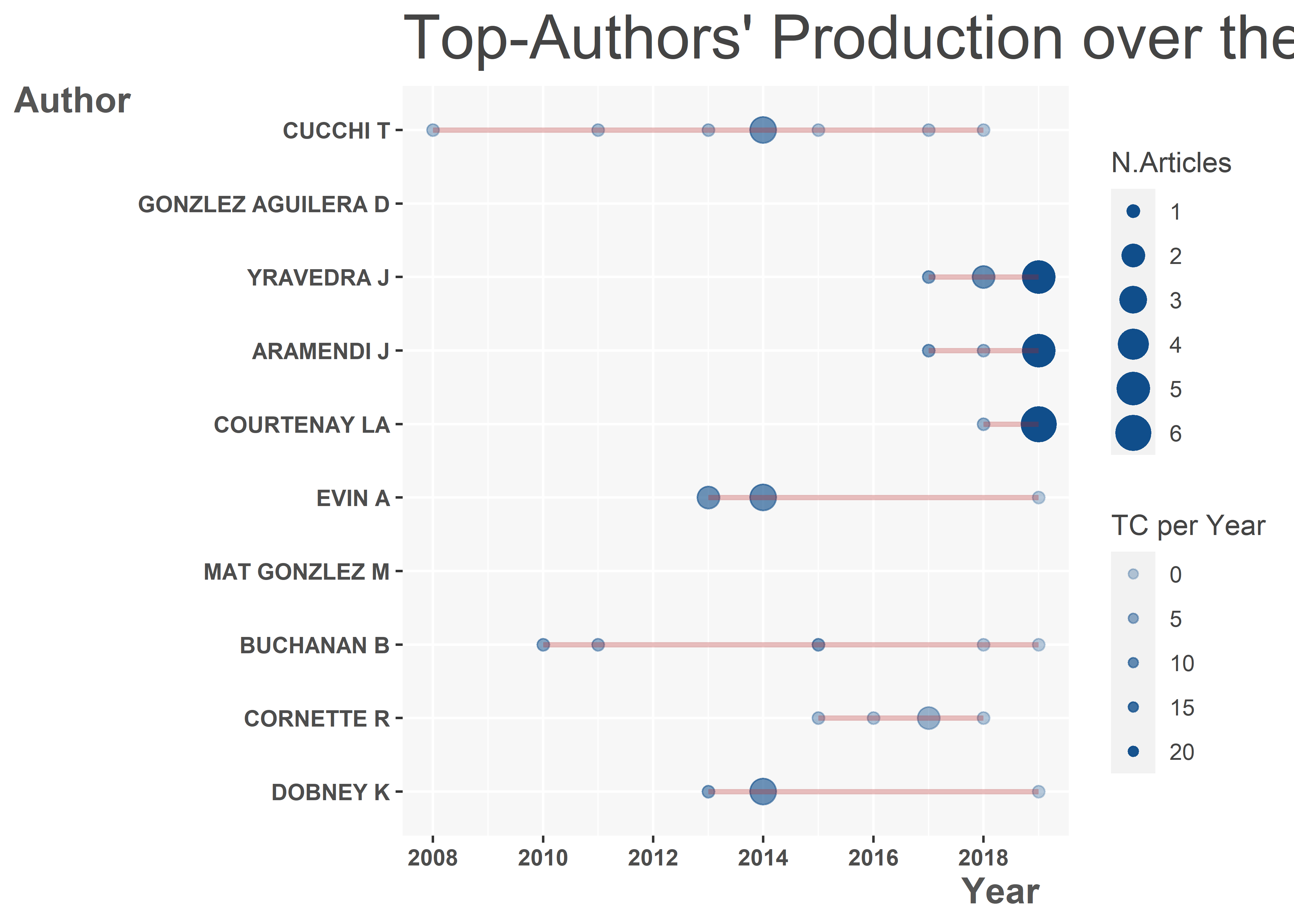
# number of documents published annually by top sources
topSO <- sourceGrowth(df, top = 10, cdf = TRUE)
topSO## Year PROCEEDINGS OF THE ROYAL SOCIETY B: BIOLOGICAL SCIENCES ARCHAEOLOGICAL AND ANTHROPOLOGICAL SCIENCES
## 2002 2002 0 0
## 2003 2003 0 0
## 2004 2004 0 0
## 2005 2005 0 0
## 2006 2006 0 0
## 2007 2007 1 0
## 2008 2008 1 0
## 2009 2009 1 0
## 2010 2010 1 0
## 2011 2011 1 0
## 2012 2012 1 0
## 2013 2013 1 0
## 2014 2014 1 0
## 2015 2015 1 0
## 2016 2016 1 0
## 2017 2017 1 1
## 2018 2018 1 1
## 2019 2019 2 3
## 2020 2020 2 3
## QUATERNARY SCIENCE REVIEWS AMERICAN JOURNAL OF PHYSICAL ANTHROPOLOGY QUATERNARY INTERNATIONAL
## 2002 0 0 0
## 2003 0 0 0
## 2004 0 0 0
## 2005 0 0 0
## 2006 0 0 0
## 2007 0 0 0
## 2008 0 0 0
## 2009 0 0 0
## 2010 0 0 0
## 2011 0 0 0
## 2012 0 1 0
## 2013 0 1 0
## 2014 0 1 1
## 2015 0 2 1
## 2016 0 2 1
## 2017 1 2 1
## 2018 3 3 1
## 2019 4 5 5
## 2020 4 5 5
## BIOLOGICAL JOURNAL OF THE LINNEAN SOCIETY JOURNAL OF ARCHAEOLOGICAL SCIENCE: REPORTS
## 2002 0 0
## 2003 0 0
## 2004 0 0
## 2005 0 0
## 2006 0 0
## 2007 0 0
## 2008 0 0
## 2009 0 0
## 2010 0 0
## 2011 0 0
## 2012 0 0
## 2013 1 0
## 2014 1 0
## 2015 1 0
## 2016 1 1
## 2017 1 2
## 2018 1 2
## 2019 2 3
## 2020 2 3
## JOURNAL OF ARCHAEOLOGICAL SCIENCE PALAEOGEOGRAPHY, PALAEOCLIMATOLOGY, PALAEOECOLOGY AMERICAN ANTIQUITY PLOS ONE
## 2002 0 0 0 0
## 2003 0 0 0 0
## 2004 0 0 0 0
## 2005 0 0 0 0
## 2006 1 0 0 0
## 2007 2 0 0 0
## 2008 3 0 0 0
## 2009 3 0 0 0
## 2010 5 0 0 0
## 2011 7 0 0 0
## 2012 8 0 0 0
## 2013 9 0 0 0
## 2014 15 0 0 0
## 2015 17 0 0 1
## 2016 18 0 0 1
## 2017 21 1 0 2
## 2018 23 1 1 3
## 2019 27 2 2 4
## 2020 27 2 2 4
## JOURNAL OF HUMAN EVOLUTION LATIN AMERICAN ANTIQUITY INTERNATIONAL JOURNAL OF LEGAL MEDICINE
## 2002 0 0 0
## 2003 0 0 0
## 2004 0 0 0
## 2005 0 0 0
## 2006 0 0 0
## 2007 0 0 1
## 2008 0 0 1
## 2009 0 0 1
## 2010 1 0 1
## 2011 3 1 1
## 2012 4 1 1
## 2013 4 1 1
## 2014 4 1 1
## 2015 5 1 1
## 2016 6 1 1
## 2017 7 1 2
## 2018 10 2 2
## 2019 10 2 2
## 2020 10 2 2
## AMERICAN JOURNAL OF HUMAN BIOLOGY ANATOMICAL RECORD
## 2002 0 0
## 2003 0 0
## 2004 0 0
## 2005 0 0
## 2006 0 0
## 2007 0 0
## 2008 0 0
## 2009 0 0
## 2010 0 0
## 2011 0 0
## 2012 0 0
## 2013 0 1
## 2014 0 1
## 2015 0 2
## 2016 2 2
## 2017 2 2
## 2018 2 2
## 2019 2 2
## 2020 2 2# plot results
tso = melt(topSO, id = 'Year')
ggplot(tso, aes(Year, value, group = variable, color = variable)) +
geom_line()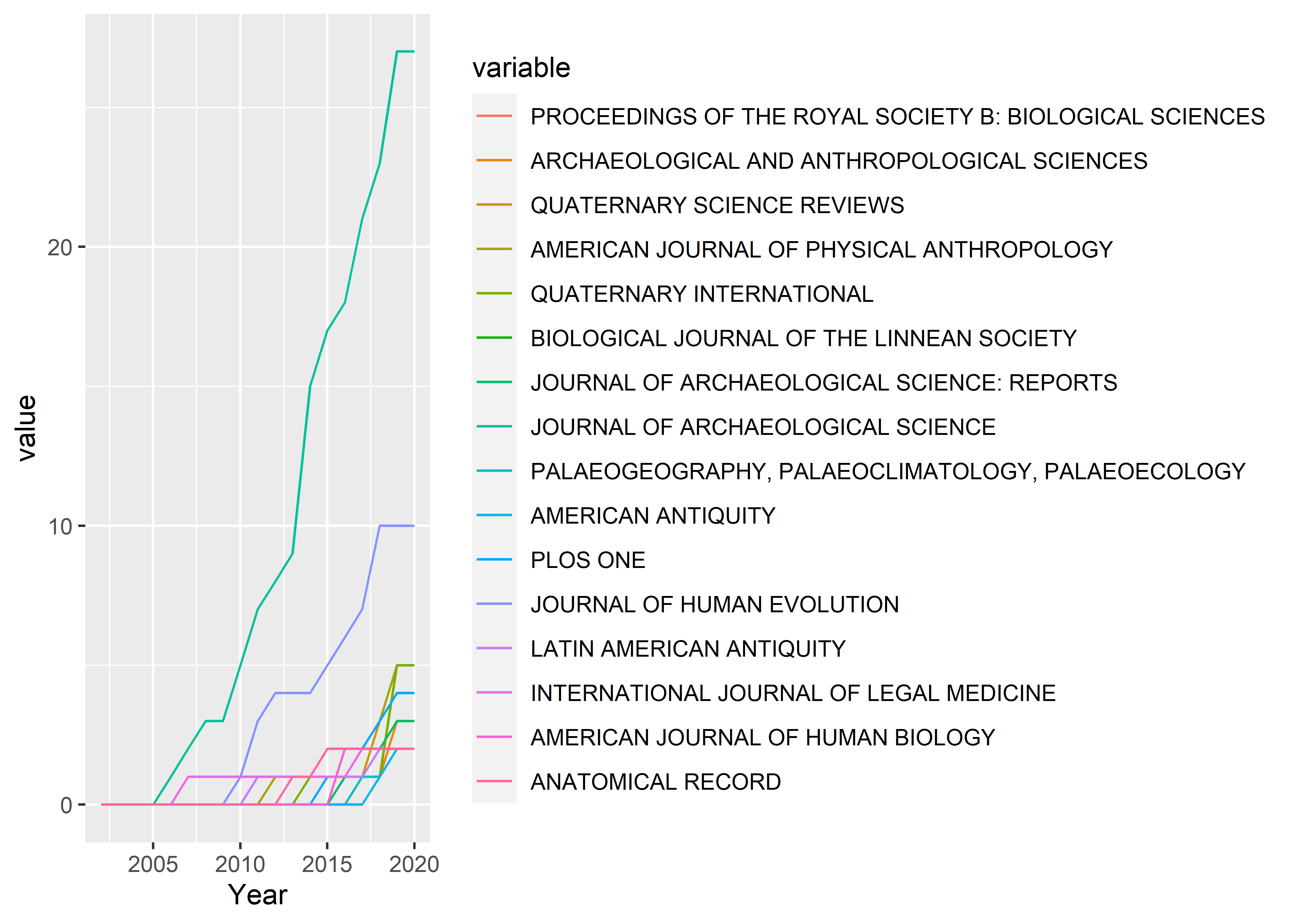
3.1.3 Sankey diagram
(#fig:3.flds)Interactive Sankey diagram of three fields (authors, keywords, and journals) illustrating relationships.
3.2 Most cited
3.2.1 Most cited articles
# most cited references in global network
mcr <- citations(df, field = "article", sep = ";")
cbind(mcr$Cited[1:20])## [,1]
## BUCHANAN, B., COLLARD, M., A GEOMETRIC MORPHOMETRICS-BASED ASSESSMENT OF BLADE SHAPE DIFFERENCES AMONG PALEOINDIAN PROJECTILE POINT TYPES FROM WESTERN NORTH AMERICA (2010) J. ARCHAEOL. SCI., 37, PP. 350-359 8
## MITTEROECKER, P., GUNZ, P., ADVANCES IN GEOMETRIC MORPHOMETRICS (2009) EVOL. BIOL., 36, PP. 235-247 8
## BOOKSTEIN, F.L., (1991) MORPHOMETRIC TOOLS FOR LANDMARK DATA: GEOMETRY AND BIOLOGY, , CAMBRIDGE UNIVERSITY PRESS, CAMBRIDGE 7
## BOOKSTEIN, F.L., MORPHOMETRIC TOOLS FOR LANDMARK DATA: GEOMETRY AND BIOLOGY (1991), CAMBRIDGE UNIVERSITY PRESS CAMBRIDGE 7
## KLINGENBERG, C.P., MORPHOJ: AN INTEGRATED SOFTWARE PACKAGE FOR GEOMETRIC MORPHOMETRICS (2011) MOL. ECOL. RESOUR., 11, PP. 353-357 7
## KLINGENBERG, C.P., MORPHOJ: AN INTEGRATED SOFTWARE PACKAGE FOR GEOMETRIC MORPHOMETRICS (2011) MOLECULAR ECOLOGY RESOURCES, 11, PP. 353-357 6
## ARCHER, W., BRAUN, D.R., VARIABILITY IN BIFACIAL TECHNOLOGY AT ELANDSFONTEIN, WESTERN CAPE, SOUTH AFRICA: A GEOMETRIC MORPHOMETRIC APPROACH (2010) JOURNAL OF ARCHAEOLOGICAL SCIENCE, 37, PP. 201-209 5
## BUCHANAN, B., COLLARD, M., HAMILTON, M.J., O'BRIEN, M.J., POINTS AND PREY: A QUANTITATIVE TEST OF THE HYPOTHESIS THAT PREY SIZE INFLUENCES EARLY PALEOINDIAN PROJECTILE POINT FORM (2011) J. ARCHAEOL. SCI., 38, PP. 852-864 5
## CUCCHI, T., HULME-BEAMAN, A., YUAN, J., DOBNEY, K., EARLY NEOLITHIC PIG DOMESTICATION AT JIAHU, HENAN PROVINCE, CHINA: CLUES FROM MOLAR SHAPE ANALYSES USING GEOMETRIC MORPHOMETRIC APPROACHES (2011) J.ARCHAEOL. SCI., 38, PP. 11-22 5
## DRYDEN, I.L., MARDIA, K.V., STATISTICAL SHAPE ANALYSIS (1998), JOHN WILEY & SONS CHICHESTER 5
## GOWER, J.C., GENERALIZED PROCRUSTES ANALYSIS (1975) PSYCHOMETRIKA, 40, PP. 33-51 5
## MITTEROECKER, P., GUNZ, P., ADVANCES IN GEOMETRIC MORPHOMETRICS (2009) EVOLUTIONARY BIOLOGY, 36, PP. 235-247 5
## ROHLF, F.J., SHAPE STATISTICS: PROCRUSTES SUPERIMPOSITIONS AND TANGENT SPACES (1999) J. CLASSIF., 16, PP. 197-223 5
## ROHLF, F.J., SLICE, D., EXTENSIONS OF THE PROCRUSTES METHOD FOR THE OPTIMAL SUPERIMPOSITION OF LANDMARKS (1990) SYST. BIOL., 39, PP. 40-59 5
## ROHLF, F.J., SLICE, D.E., EXTENSIONS OF THE PROCRUSTES METHOD FOR THE OPTIMAL SUPERIMPOSITION OF LANDMARKS (1990) SYST. ZOOL., 39, PP. 40-59 5
## SLICE, D.E., GEOMETRIC MORPHOMETRICS (2007) ANNU. REV. ANTHROPOL., 36, PP. 261-281 5
## SLICE, D.E., GEOMETRIC MORPHOMETRICS (2007) ANNUAL REVIEW OF ANTHROPOLOGY, 36, PP. 261-281 5
## SLICE, D.E., LANDMARK COORDINATES ALIGNED BY PROCRUSTES ANALYSIS DO NOT LIE IN KENDALL'S SHAPE SPACE (2001) SYST. BIOL., 50 (1), PP. 141-149 5
## ADAMS, D.C., ROHLF, F.J., SLICE, D.E., A FIELD COMES OF AGE: GEOMETRIC MORPHOMETRICS IN THE 21ST CENTURY (2013) HYSTRIX, 24, PP. 7-14 4
## BOOKSTEIN, F.L., (1991) MORPHOMETRIC TOOLS FOR LANDMARK DATA: GEOMETRY AND BIOLOGY, , CAMBRIDGE: CAMBRIDGE UNIVERSITY PRESS 43.3 The intellectual structure of geometric morphometrics in archaeology
3.3.1 Reference co-citation
# article co-citation network
comat1 <- biblioNetwork(df, analysis = "co-citation", network = "references", sep = ";")
# network plot
conet1 = networkPlot(comat1, n = 50, Title = "Reference Co-Citation Network", type = "auto", size = 20, size.cex = T, remove.multiple = FALSE, labelsize = 0.4, edgesize = 5, edges.min = 3)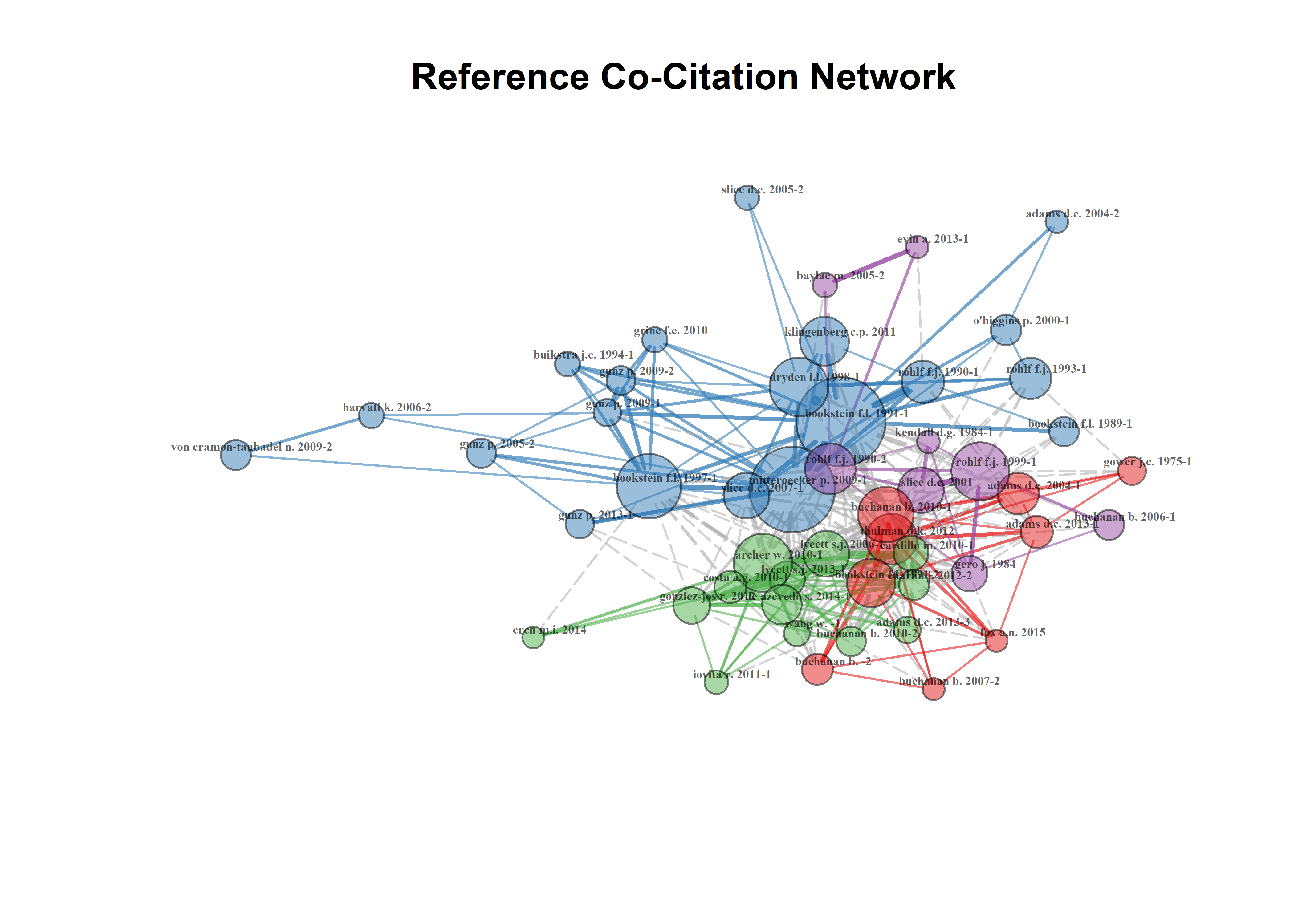
# descriptive analysis of journal co-citation network
aconetstat <- networkStat(comat1)
summary(aconetstat, k = 15)##
##
## Main statistics about the network
##
## Size 6825
## Density 0.018
## Transitivity 0.642
## Diameter 5
## Degree Centralization 0.277
## Average path length 2.561
## 3.4 Historiograph direct citation linkages
# historical citation network
options(width = 100)
histResults <- histNetwork(df, min.citations = 5, sep = ";")##
## SCOPUS DB: Searching local citations (LCS) by document titles (TI) and DOIs...
##
## Found 42 documents with no empty Local Citations (LCS)# plot historical co-citation network
hnet <- histPlot(histResults, n = 50, size = 4, labelsize = 2)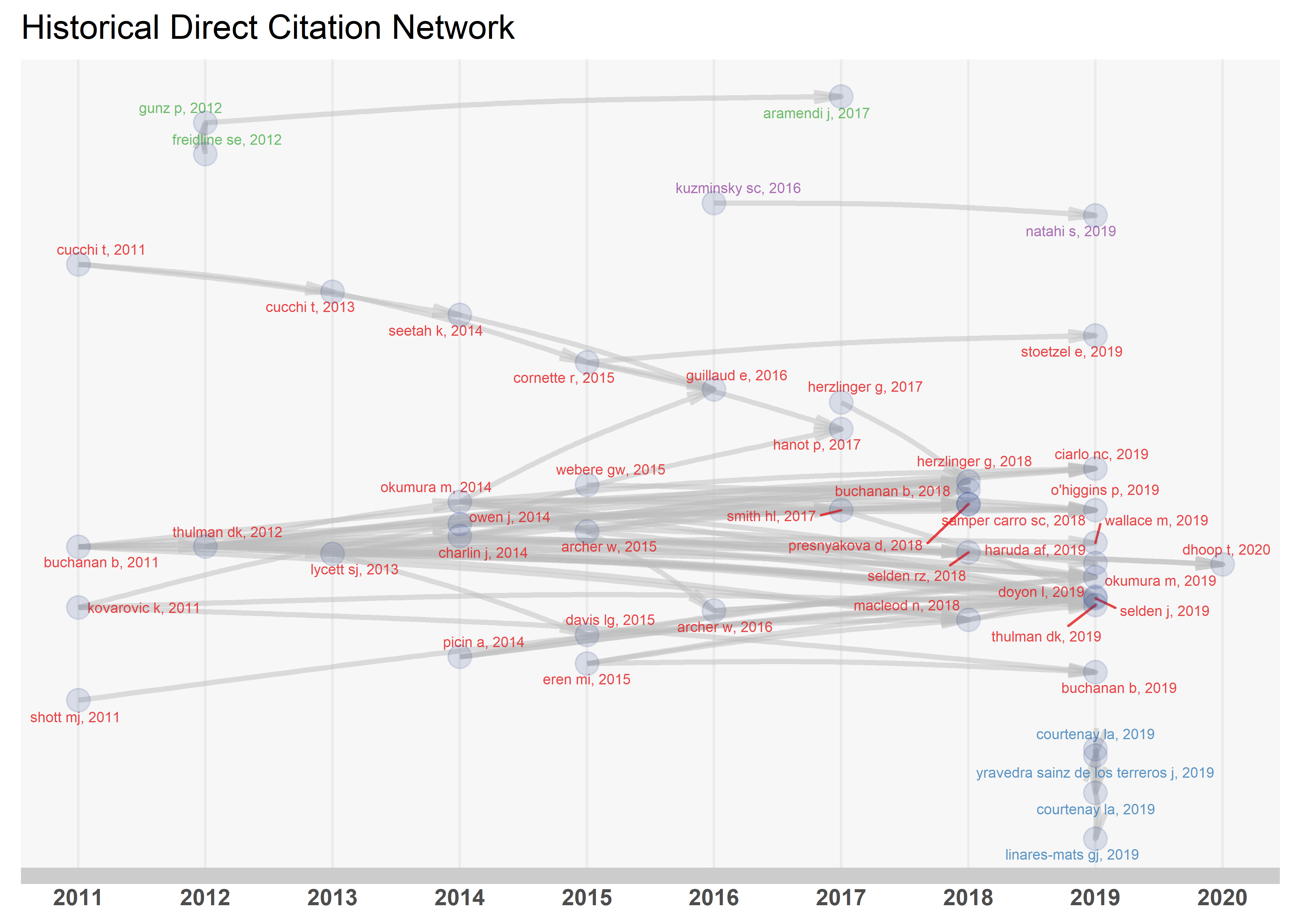
Figure 3.1: The historiographic map is a chronological network map of the most relevant direct citations resulting from this bibliographic collection.
##
## Legend
##
## Paper DOI Year
## 1 VIOARSDTTIR US, 2002, J ANAT 10.1046/J.1469-7580.2002.00092.X 2002
## 2 LYCETT SJ, 2006, J ARCHAEOL SCI 10.1016/J.JAS.2005.10.014 2006
## 3 BRAGA J, 2007, INT J LEG MED 10.1007/S00414-007-0170-X 2007
## 7 CARDILLO M, 2010, LECT NOTES EARTH SCI 10.1007/978-3-540-95853-6_15 2010
## 9 ARCHER W, 2010, J ARCHAEOL SCI 10.1016/J.JAS.2009.09.033 2010
## 12 SHOTT MJ, 2011, EVOL EDU OUTREACH 10.1007/S12052-011-0344-3 2011
## 13 CASTIEIRA C, 2011, LAT AM ANTIQ 10.7183/1045-6635.22.3.335 2011
## 14 KOVAROVIC K, 2011, J ARCHAEOL SCI 10.1016/J.JAS.2011.06.028 2011
## 15 BUCHANAN B, 2011, J ARCHAEOL SCI 10.1016/J.JAS.2010.11.007 2011
## 16 DE GROOTE I, 2011, J HUM EVOL 10.1016/J.JHEVOL.2010.09.009 2011
## 17 BERMDEZ DE CASTRO JM, 2011, J HUM EVOL 10.1016/J.JHEVOL.2011.03.005 2011
## 18 GUNZ P, 2012, AM J PHYS ANTHROPOL 10.1002/AJPA.22133 2012
## 19 THULMAN DK, 2012, J ARCHAEOL SCI 10.1016/J.JAS.2012.01.004 2012
## 20 FREIDLINE SE, 2012, J HUM EVOL 10.1016/J.JHEVOL.2011.11.005 2012
## 21 KRAUSE-KYORA B, 2013, NAT COMMUN 10.1038/NCOMMS3348 2013
## 22 SENCK S, 2013, ANAT REC 10.1002/AR.22693 2013
## 23 CUCCHI T, 2013, BIOL J LINN SOC 10.1111/BIJ.12004 2013
## 25 DTROIT F, 2013, HUM BIOL 10.3378/027.085.0303 2013
## 26 OKUMURA M, 2014, J ARCHAEOL SCI 10.1016/J.JAS.2014.02.009 2014
## 28 PICIN A, 2014, QUAT INT 10.1016/J.QUAINT.2014.05.004 2014
## 29 OWEN J, 2014, J ARCHAEOL SCI 10.1016/J.JAS.2013.12.010 2014
## 30 NOVA DELGADO M, 2014, FOLIA PRIMATOL 10.1159/000371633 2014
## 31 ROS J, 2014, J ARCHAEOL SCI 10.1016/J.JAS.2013.09.015 2014
## 32 WILCZEK J, 2014, J ARCHAEOL SCI 10.1016/J.JAS.2014.05.033 2014
## 33 EVIN A, 2014, J ARCHAEOL SCI 10.1016/J.JAS.2013.11.033 2014
## 34 SEETAH K, 2014, J ARCHAEOL SCI 10.1016/J.JAS.2013.10.022 2014
## 43 FIELD JH, 2016, J ANTHROPOL ARCHAEOL 10.1016/J.JAA.2016.07.007 2016
## 44 KUBICKA AM, 2016, AM J HUMAN BIOL 10.1002/AJHB.22873 2016
## 45 FERROS I, 2016, ORTHODONT CRANIOFAC RES 10.1111/OCR.12128 2016
## 46 ARCHER W, 2016, J HUM EVOL 10.1016/J.JHEVOL.2016.05.007 2016
## 47 GUILLAUD E, 2016, J ARCHAEOL SCI 10.1016/J.JAS.2015.11.010 2016
## 48 PASCHETTA C, 2016, AM J HUMAN BIOL 10.1002/AJHB.22746 2016
## 49 ARAMENDI J, 2017, PALAEOGEOGR PALAEOCLIMATOL PALAEOECOL 10.1016/J.PALAEO.2017.05.021 2017
## 50 WOODS C, 2017, PLOS ONE 10.1371/JOURNAL.PONE.0186754 2017
## 51 SMITH HL, 2017, ARCHAEOL ANTHROPOL SCI 10.1007/S12520-016-0335-Y 2017
## 52 ESTVEZ EJ, 2017, INT J LEG MED 10.1007/S00414-017-1659-6 2017
## 53 CORNY J, 2017, J HUM EVOL 10.1016/J.JHEVOL.2017.08.017 2017
## 54 BONHOMME V, 2017, J ARCHAEOL SCI 10.1016/J.JAS.2017.09.010 2017
## 55 HERZLINGER G, 2017, J ARCHAEOL SCI REP 10.1016/J.JASREP.2017.05.013 2017
## 56 ERRICKSON D, 2017, INT J OSTEOARCHAEOL 10.1002/OA.2587 2017
## 57 STOETZEL E, 2017, QUAT SCI REV 10.1016/J.QUASCIREV.2017.04.002 2017
## 58 NELSON E, 2017, J ARCHAEOL SCI 10.1016/J.JAS.2016.11.001 2017
## 59 HANOT P, 2017, J ARCHAEOL SCI 10.1016/J.JAS.2016.12.002 2017
## 60 MRQUEZ F, 2017, MAR POLLUT BULL 10.1016/J.MARPOLBUL.2016.11.018 2017
## 61 MACLEOD N, 2018, QUAT SCI REV 10.1016/J.QUASCIREV.2018.08.024 2018
## 62 PRESNYAKOVA D, 2018, J HUM EVOL 10.1016/J.JHEVOL.2018.07.008 2018
## 63 LIMIER B, 2018, J ARCHAEOL SCI 10.1016/J.JAS.2018.10.001 2018
## 64 HERZLINGER G, 2018, PLOS ONE 10.1371/JOURNAL.PONE.0207890 2018
## 65 SAMPER CARRO SC, 2018, J ARCHAEOL SCI 10.1016/J.JAS.2018.09.010 2018
## 66 BUCHANAN B, 2018, AM ANTIQ 10.1017/AAQ.2018.53 2018
## 67 SELDEN RZ, 2018, DIGIT APPL ARCHAEOL CULT HERIT 10.1016/J.DAACH.2018.E00080 2018
## 68 MOUNIER A, 2018, J HUM EVOL 10.1016/J.JHEVOL.2018.04.013 2018
## 69 ROFES J, 2018, QUAT SCI REV 10.1016/J.QUASCIREV.2018.04.016 2018
## 70 MAT-GONZLEZ M, 2018, ARCHAEOMETRY 10.1111/ARCM.12327 2018
## LCS GCS
## 1 4 146
## 2 13 78
## 3 0 36
## 7 8 35
## 9 13 74
## 12 1 5
## 13 0 30
## 14 3 101
## 15 6 47
## 16 0 25
## 17 0 56
## 18 1 8
## 19 14 68
## 20 1 35
## 21 0 55
## 22 1 11
## 23 1 20
## 25 1 23
## 26 7 50
## 28 3 19
## 29 4 28
## 30 0 4
## 31 0 23
## 32 0 12
## 33 0 20
## 34 1 18
## 43 0 9
## 44 0 3
## 45 0 4
## 46 2 16
## 47 0 7
## 48 0 4
## 49 0 31
## 50 0 4
## 51 1 7
## 52 0 3
## 53 0 8
## 54 1 9
## 55 1 8
## 56 0 7
## 57 1 6
## 58 2 8
## 59 0 9
## 60 0 15
## 61 2 6
## 62 0 6
## 63 0 2
## 64 0 3
## 65 0 1
## 66 0 2
## 67 0 1
## 68 0 1
## 69 0 2
## 70 1 183.4.1 Field tag distribution by year
timespan = c(2005, 2010, 2015)
ftd <- fieldByYear(df, field = "DE", timespan = timespan, min.freq = 3, n.items = 5, labelsize = 3, graph = TRUE)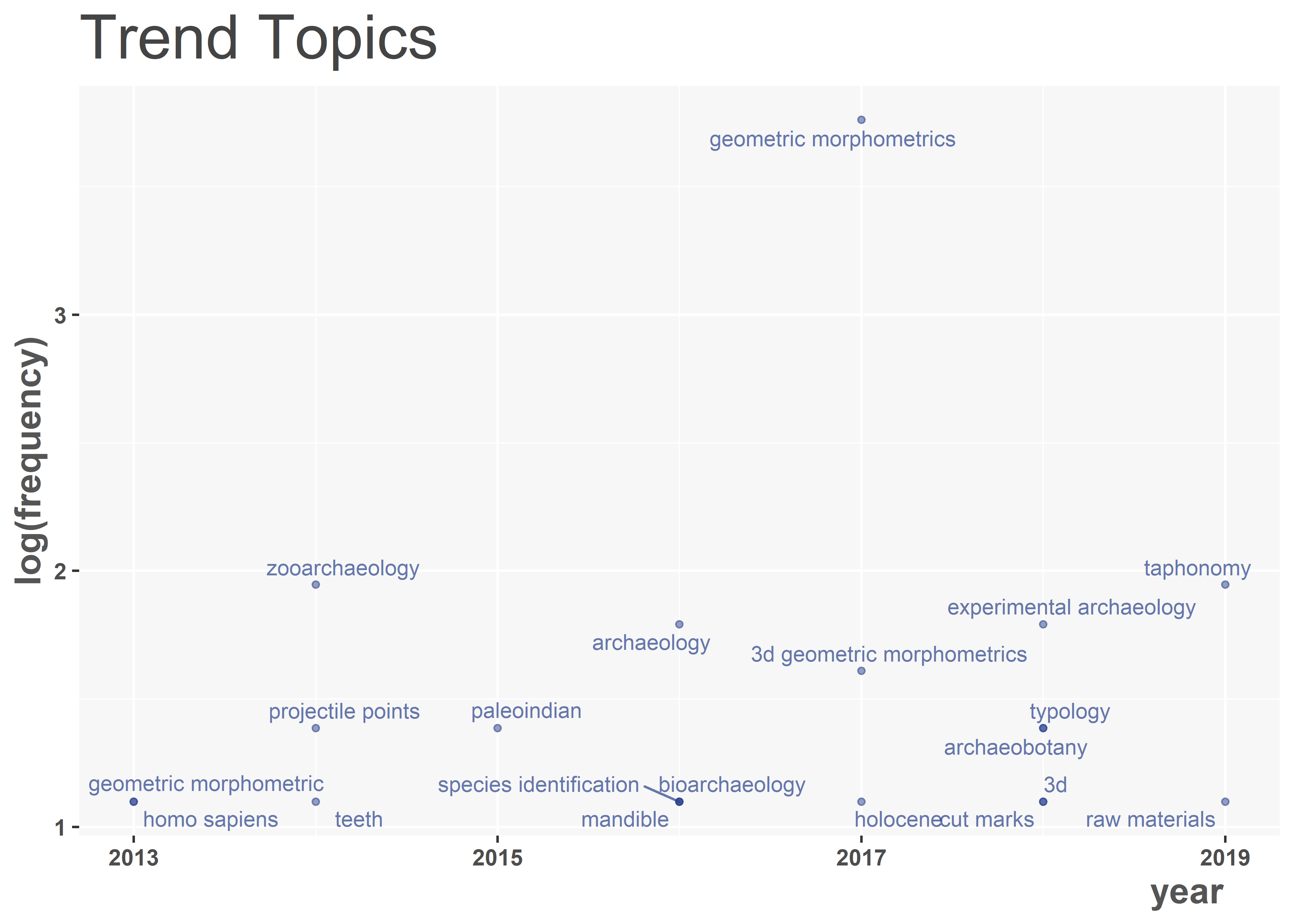
3.4.2 ID and DE keyword associations
list <- keywordAssoc(df, sep = ";", n = 10, excludeKW = c("geometric morphometric","geometric morphometrics"))
names(list)## [1] "ARCHAEOLOGY" "MORPHOMETRY" "ARCHEOLOGY" "HUMAN" "MORPHOLOGY" "PLEISTOCENE"
## [7] "PALEOLITHIC" "GEOMETRY" "HUMANS" "PHENOTYPE"## ZOOARCHAEOLOGY TAPHONOMY PROJECTILE POINTS ARCHAEOBOTANY
## 7 5 4 3
## EXPERIMENTAL ARCHAEOLOGY PALEOINDIAN MANDIBLE HOMO SAPIENS
## 3 3 3 3
## SPECIES IDENTIFICATION TEETH
## 3 33.4.3 Yearly occurrences of top keywords/terms
## Year GEOMETRIC MORPHOMETRICS TAPHONOMY ZOOARCHAEOLOGY ARCHAEOLOGY EXPERIMENTAL ARCHAEOLOGY
## 1 2002 0 0 0 0 0
## 2 2003 0 0 0 0 0
## 3 2004 0 0 0 0 0
## 4 2005 0 0 0 0 0
## 5 2006 0 0 0 0 0
## 6 2007 2 0 0 0 0
## 7 2008 2 0 1 0 0
## 8 2009 2 0 1 0 0
## 9 2010 4 0 1 0 1
## 10 2011 8 0 2 0 1
## 11 2012 9 0 2 0 1
## 12 2013 10 0 2 0 1
## 13 2014 14 0 4 2 1
## 14 2015 18 1 4 2 1
## 15 2016 20 1 4 3 1
## 16 2017 27 2 5 4 2
## 17 2018 32 3 6 4 3
## 18 2019 42 7 7 6 6
## 19 2020 43 7 7 6 6
## 3D GEOMETRIC MORPHOMETRICS ARCHAEOBOTANY PALEOINDIAN PROJECTILE POINTS TYPOLOGY
## 1 0 0 0 0 0
## 2 0 0 0 0 0
## 3 0 0 0 0 0
## 4 0 0 0 0 0
## 5 1 0 0 0 0
## 6 1 0 0 0 0
## 7 1 0 0 0 0
## 8 1 0 0 0 0
## 9 1 0 1 1 0
## 10 1 0 1 2 0
## 11 1 0 2 2 1
## 12 1 0 2 2 1
## 13 1 1 2 2 1
## 14 1 1 2 2 1
## 15 1 1 2 2 1
## 16 3 2 2 2 1
## 17 3 3 3 3 2
## 18 5 4 4 4 4
## 19 5 4 4 4 4# plot results
key.plot = melt(topKW, id='Year')
ggplot(key.plot, aes(Year, value, group = variable, color = variable)) +
geom_line()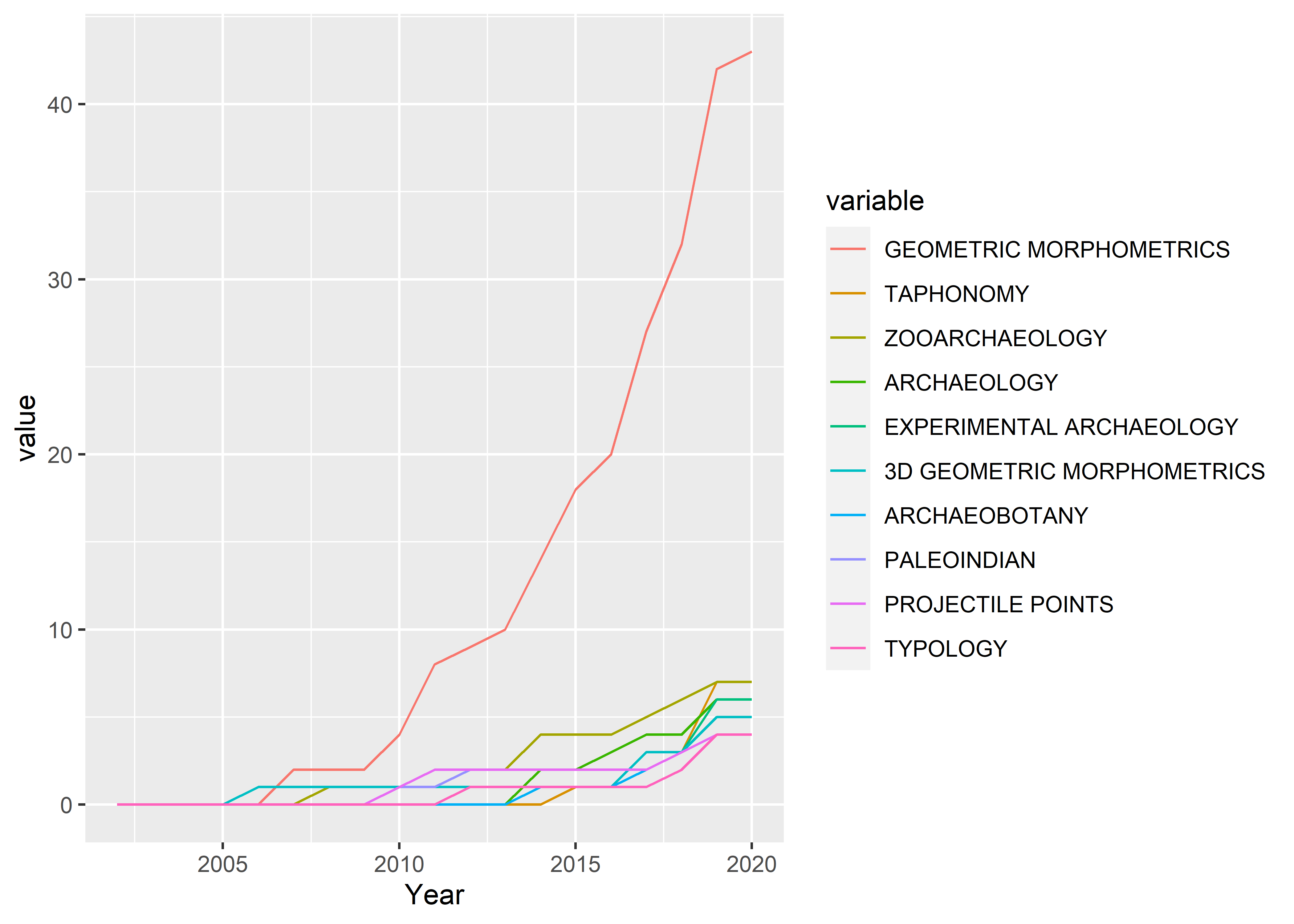
3.5 The conceptual structure of geometric morphometrics in archaeology
3.5.1 Co-word analysis through keyword co-occurrences
# keyword co-occurrences network
keymat1 <- biblioNetwork(df, analysis = "co-occurrences", network = "keywords", sep = ";")
# networkplot
keynet1 = networkPlot(keymat1, normalize = "association", n = 50, Title = "Keyword Co-occurrences", type = "auto", size = 5, edgesize = 2, labelsize = 0.4)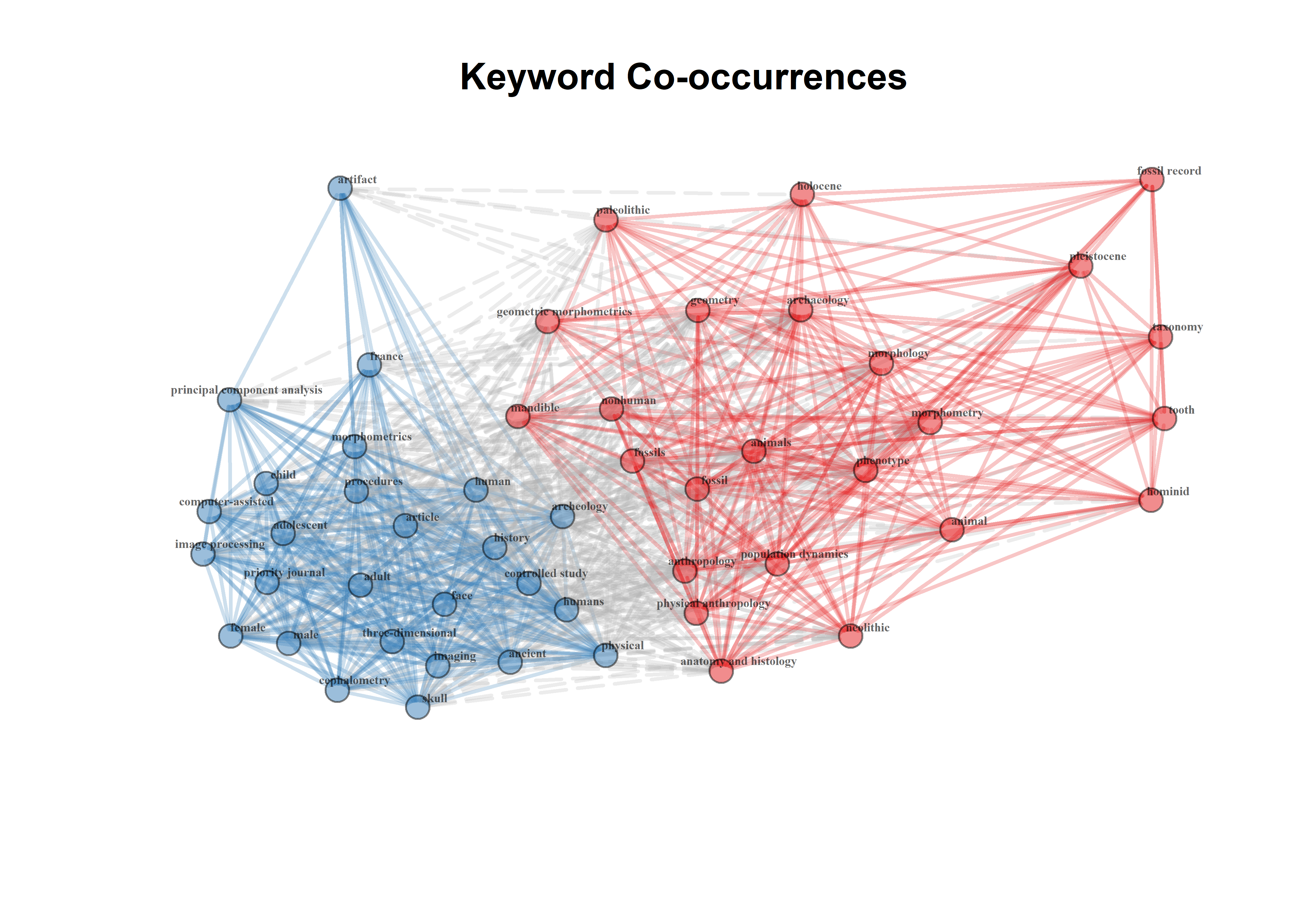
3.5.2 Co-word analysis via Metric Multidimensional Scaling
# using authors keywords
cw <- conceptualStructure(df, field = "DE", method = "MDS", minDegree = 3, clust = "auto", stemming = FALSE, labelsize = 8, documents = 15)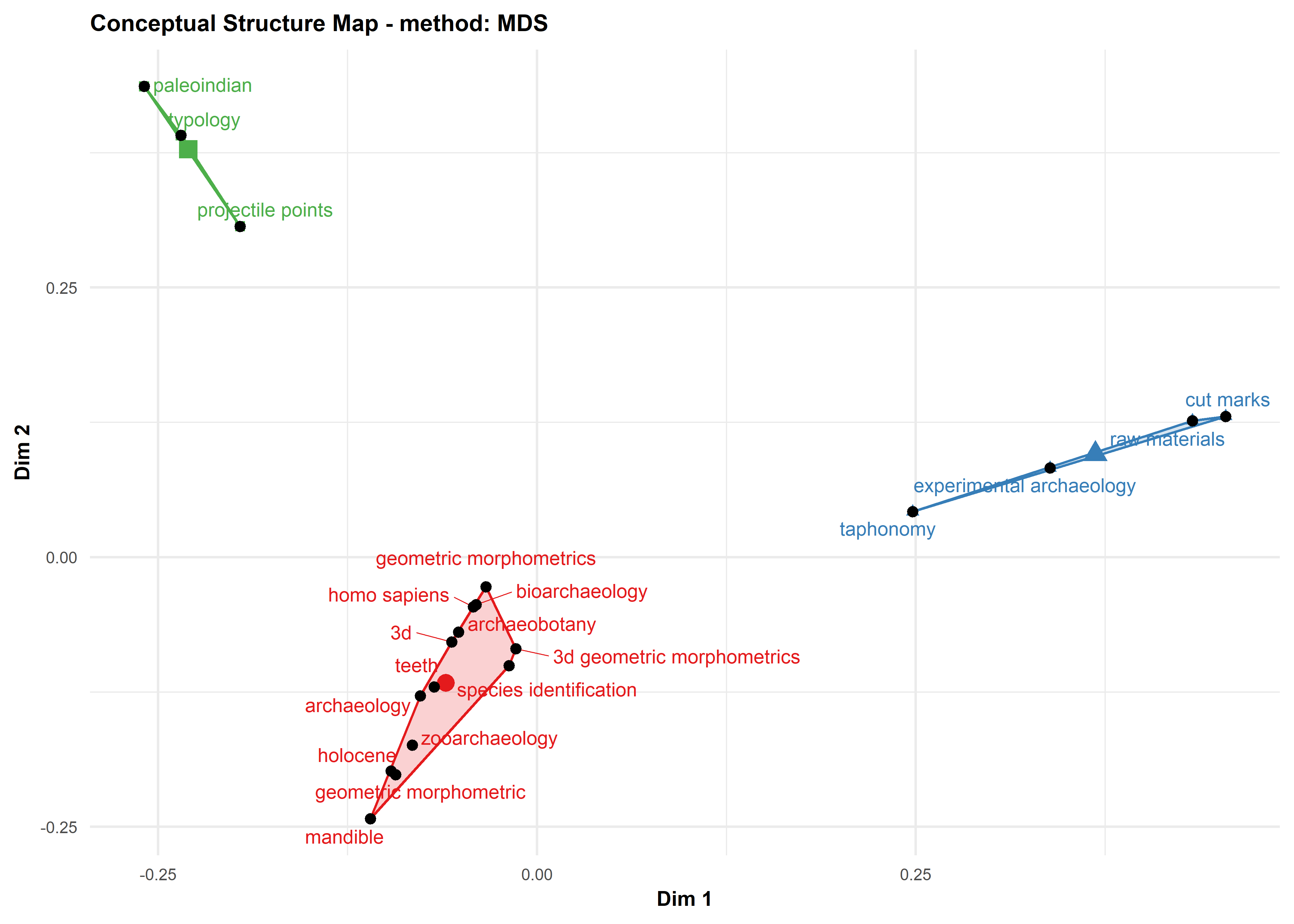
(#fig:co.word11)Co-word analysis was used to map the conceptual structure of the research domain using co-occurrence of keywords in the bibliographic collection.
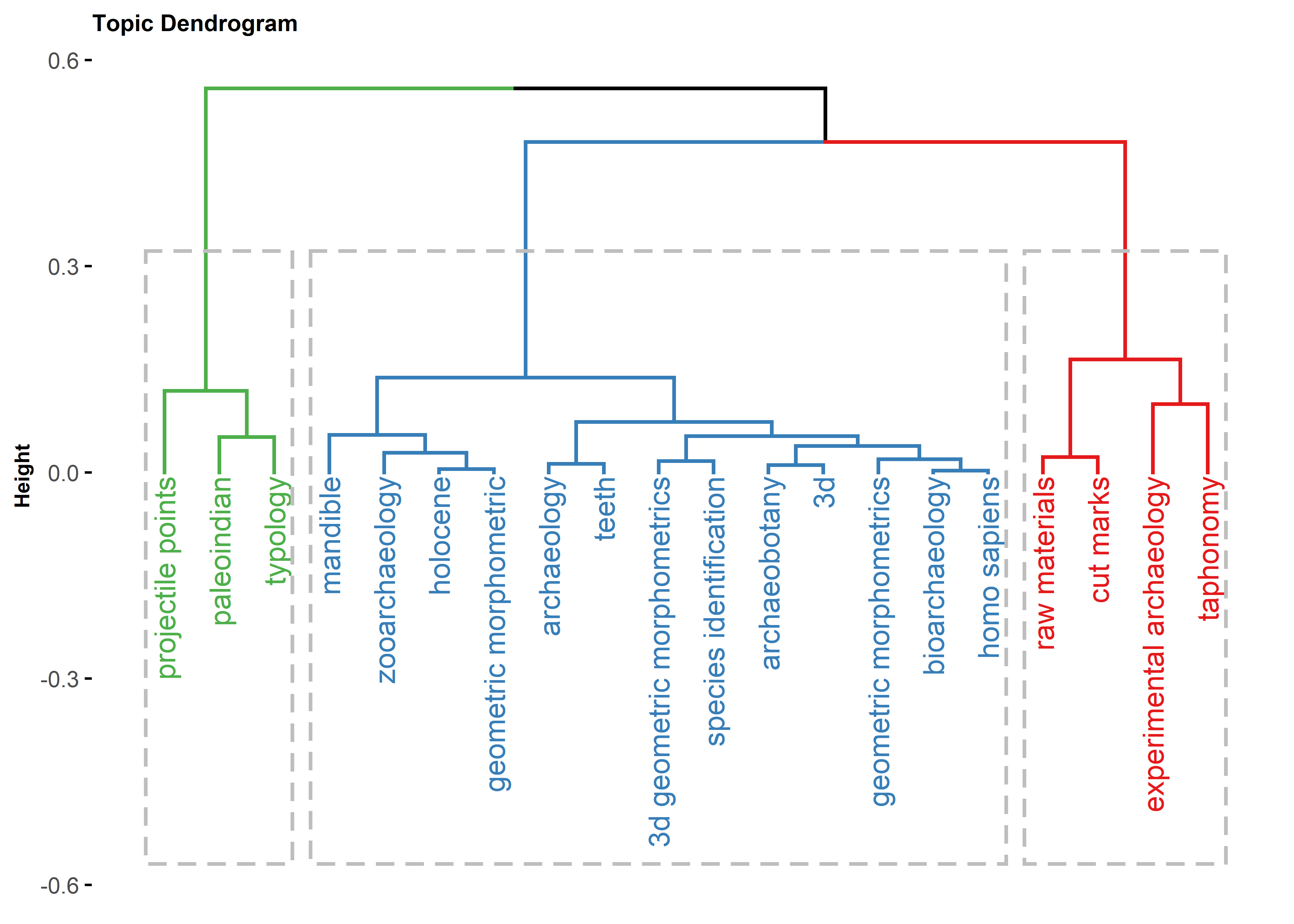
(#fig:co.word12)Co-word analysis was used to map the conceptual structure of the research domain using co-occurrence of keywords in the bibliographic collection.
3.6 Thematic mapping
From (Cobo et al. 2011, 150–51):
- Themes in the upper-right quadrant are both well developed and important for the structuring ofa research field. They are known as the motor-themes of the specialty, given that they present strong centrality and high density. The placement of themesin this quadrantimplies that theyare related externally to concepts applicable to otherthemesthat are conceptually closely related.
- Themes in the upper-left quadrant have well developed internal ties but unimportant external ties and so are of only marginal importance for the field. These themes are very specialized and peripheral in character.
- Themes in the lower-left quadrant are both weakly developed and marginal. The themes ofthis quadrant have low density and low centrality, mainly representing either emerging or disappearing themes.
- Themes in the lower-right quadrant are important for a research field but are not developed. So, this quadrant groups transversal and general, basic themes.
# keyword map
map1 = thematicMap(df, field = "DE", n = 1000, minfreq = 3, stemming = FALSE, size = 0.8, n.labels = 1, repel = TRUE)
# plot map
plot(map1$map)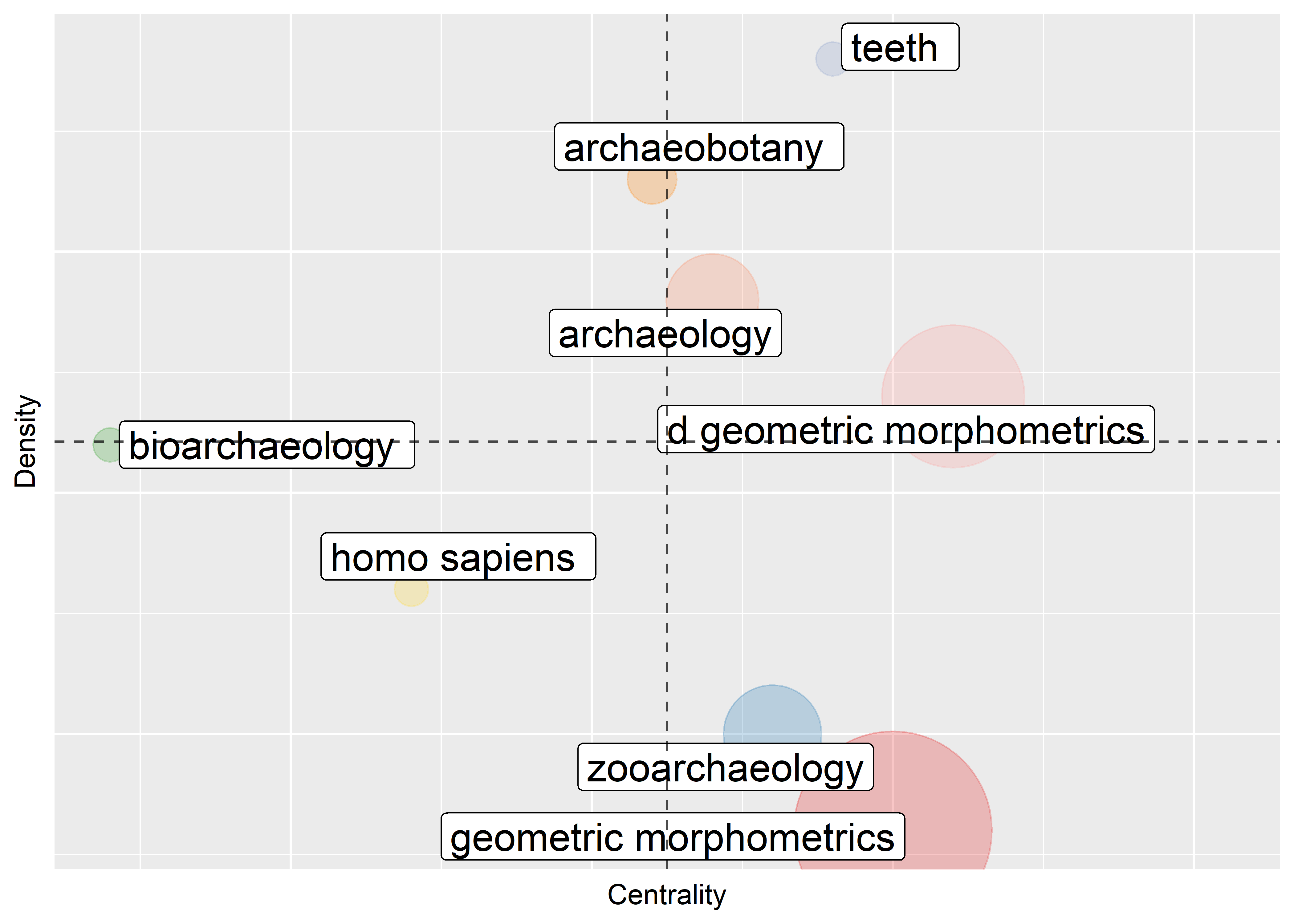
References
Cobo, M. J., A. G. López-Herrera, E. Herrera-Viedma, and F. Herrera. 2011. “An Approach for Detecting, Quantifying, and Visualizing the Evolution of a Research Field: A Practical Application to the Fuzzy Sets Theory Field.” Journal Article. Journal of Informetrics 5 (1): 146–66. https://doi.org/10.1016/j.joi.2010.10.002.

3.7 Social structure of geometric morphometrics in archaeology
3.7.1 Author collaboration
(#fig:auth.collab)In this figure, scientific collaborations are plotted where nodes are authors and links are co-authorships, illustrating collaborations between authors.
3.7.2 Edu collaboration
(#fig:edu.collab)In this figure, scientific collaborations are plotted where nodes are institutions and links are co-authorships, illustrating collaborations between institutions.
3.7.3 Country collaboration
(#fig:count.collab)In this figure, scientific collaborations are plotted where nodes are countries and links are co-authorships, illustrating collaborations between countries